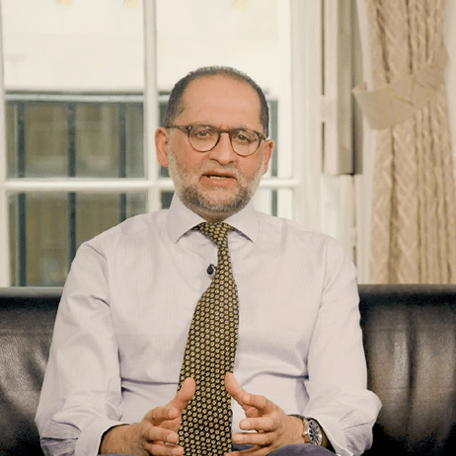Investors are currently faced with a multi-trillion-dollar conundrum. Global growth in 2023 seems likely to prove more resilient than expected. That’s good news. More resilient global growth may make it harder for central banks to bring inflation back down to their targets. That’s bad news.
What does this combo mean for financial markets? Will negative news on inflation outweigh positive news on growth, and to what extent? This is the multi-trillion-dollar conundrum. Sometimes it pays not to overcomplicate matters. In simple terms, it seems likely that good news on growth will feed through to markets before the bad news on inflation arrives. Equally, while there are upside risks to inflation from stronger global demand, there are also significant downward pressures on inflation already in train, including the return to the smooth operation of global supply chains. However, renewed inflationary pressures could well complicate the outlook moving through 2023.
The current situation is a conundrum as the risks are not one-sided; it is not all about potential downside surprises, there are also plausible outcomes on the other side of the distribution. While currently very few investors are even willing to entertain the chance, global growth could prove more resilient than expected and inflation could also continue to decline despite stronger demand. Factors which could contribute to this seemingly outlandish scenario would be the complete normalization of global supply chains as a result of Chinese manufacturing coming fully back online and the return to the G7 workforce of inactive workers as fears around the pandemic finally fade, coupled with higher investment from companies in measures to improve productivity in response to wage pressures. While currently seen as unlikely, this more favourable out-turn is a possibility worth considering.
There is currently a marked disconnect between consensus views on the macro outlook and price action in financial markets. Entering 2023, the consensus was overwhelmingly bearish, with an EU recession seen as a slam dunk and a US recession seen as highly likely. Equity markets were widely forecast to fall in H1 and then rally in H2. Instead, equity markets have rallied sharply in January, led by cyclicals, with the much-maligned markets in Europe and China topping the tables. What’s going on? There seem to be a number of factors at play.
1. European gas prices have collapsed. Prior to 2021, the trading range for natural gas in Europe was €8-35/MWh (the long run average was €19/MWh). Then Russia invaded Ukraine and the gas price rocketed, hitting a high of €311 in August 2022, nearly 10 times the previous high. However, this spike was followed by an equally rapid collapse; European gas is now trading at €57, 82% off the highs. The spike which topped out in August 2022 was a result of Europe going out into the LNG market and literally bidding for all available cargoes, more or less at any price. Europe has significant gas storage capacity and it wanted it full to the brim going into the winter to avoid any shortfalls in the likely event Russia curtailed flows completely. High gas prices in the summer are painful, but usage during those months is relatively low and they are nowhere near as painful as gas outages, price spikes and blackouts in the winter. Europe successfully filled its storage, with German gas storage hitting 95% in October 2022. Then Europe had a significant stroke of luck, with a warmer than average winter. On top of this, even adjusting for weather, EU gas demand is running over 10% lower than normal as households and firms have economised due to higher prices. As a result, Europe has pulled back from the LNG market, which has allowed supply and demand to move back into balance and prices have collapsed from levels that were required to ration scarce supply to more ‘normal’ levels. The over 80% slump in gas prices has taken pressure off both consumers and industrial users. By the end of 2022, an EU recession was seen as the Michael Jordan of slam dunks, guaranteed. As gas prices plummeted, the picture brightened. On 10 January 2023, the Goldman Sachs Economics team revised up their EU GDP forecast to +0.6% and stated they no longer expected a technical recession in the euro area. Sometimes the inevitable turns out to be not that inevitable after all, and when everyone has positioned for the inevitable and it does not turn up there can be spectacular price moves, which is part of what happened in January.
2. China goes for growth. The consensus view up until December 2022 was that China would maintain its economy-crushing Zero Covid policy until at least the spring of 2023. It would have to wait until after the winter flu season to avoid a significant spike in cases overwhelming its health system. Or so the argument went. However, with Xi Jinping’s position secured by the Party Congress in October 2022 and with the economy under massive pressure from the Zero Covid controls plus the property bust, the Party decided that getting the economy back on track was of paramount importance. In early December 2022, the Chinese Government undertook one of the more stunning volte faces of recent years and abandoned its Zero Covid policy in the middle of the flu season. Clearly, the economic pressures had reached breaking point and caution was thrown to the wind. However, it’s not just the end of Zero Covid. China has been working on multiple fronts to boost growth. On 6 January 2023, China announced it may ease the three red lines property rules - the limits on borrowing and liquidity of property developers which have hammered its property market. This was followed by a range of measures to boost the property sector. China had announced a 16-point plan to boost the property sector in October 2022. In January 2023, it followed this with a 21-point plan to provide financing to ‘quality developers’. The Government also announced at its annual policy meeting in January 2023 that it would support China’s biggest tech companies in 2023, signalling the end of its draconian crackdown on the sector which has hit growth in investment. Finally, there has also been a clear step back from its more belligerent foreign policy stance, which it has belatedly realised has been counterproductive.
3. EPS (earnings per share) forecasts were slashed coming into Q4 reporting, and expectations for 2023 are now very low. There have been numerous press articles telling you how EPS forecasts are too optimistic and will be cut, and this will drive the equity market to new lows. As is usually the case, the press picks up on these things somewhat after the fact. The bar had already been significantly lowered heading into Q4 2022 reporting. Analysts have also been very busy taking the knife to their 2023 EPS forecasts, particularly in Europe. The only time that European EPS forecasts were anywhere near as conservative as they currently are was in 2009, and even then analysts were forecasting 2.3% EPS growth. Low expectations are generally a very good starting point.
4. Credit spreads have rolled over. High yield credit has long been seen as the canary in the economic coal mine. During 2022, with recessionary fears hitting fever pitch, high yield credit spreads ballooned to levels last seen at the peak of the pandemic. In Europe, the Markit iTraxx Xover index of high yield CDS (credit default swap) jumped from 240 in December 2021 to just below 700 in November 2022; it has now declined to 421. In the US, the Markit CDX High Yield index of CDS jumped from 300 in December 2021 to 640 in September 2022; it has since fallen to 444. The decline in credit spreads indicates that the economic outlook is likely to be more positive than many feared.
5. Leading inflation data are pointing to a marked easing in pricing pressures. For instance, in the US, PPI of Finished Goods has rolled over very sharply. The data are noisy month to month but if we focus on the six-month moving average, it peaked at a whopping +23% YoY in June 2022 and has subsequently fallen into deflationary territory, hitting -6% currently. That’s quite a swing and indicates deflationary pressure in supply chains. This is starting to show through in terms of companies’ pricing intentions. The NFIB Survey of small businesses includes a question on pricing plans. The net percentage of companies looking to raise prices peaked at a record breaking 54 in November 2021 (a 50-year high). It has now fallen back to 24, only just above the long-term average of 21. In the labour market, there are also clear signs of cooling. Weekly hours is a sort of relief valve for the labour market. If firms can’t get hold of enough workers, they can adjust by pushing up hours for their existing workers. Similarly, if firms have too many workers, they can adjust by cutting hours. During 2021, as firms struggled to recruit, they pushed up hours to a peak of 35 in January 2021. This led to accelerating wage inflation. However, as these pressures have eased, firms have been cutting hours. This indicates a loosening labour market, which should lead to lower wage pressures. Bears will argue that many of these changes are happening in the goods sector, which has seen weakening demand, and it is the service sector that is currently driving inflation. However, there are also clear signs of weakening pricing pressures in the service sector as well. The ISM Services Prices Paid index hit a record high of 85 in December 2021 and has subsequently fallen to 68, which is still above the average of 60 but is heading in the right direction. This all adds up to a picture of cooling pricing pressures.
KEY RISKS
Past performance is not a guide to future performance. The value of an investment and the income generated from it can fall as well as rise and is not guaranteed. You may get back less than you originally invested. The issue of units/shares in Liontrust Funds may be subject to an initial charge, which will have an impact on the realisable value of the investment, particularly in the short term. Investments should always be considered as long term. Investment in funds managed by the Global Fundamental Team may involve investment in smaller companies. These stocks may be less liquid and the price swings greater than those in, for example, larger companies. Some of the funds may hold a concentrated portfolio of stocks, meaning that if the price of one of these stocks should move significantly, this may have a notable effect on the value of that portfolio. Investment in the funds may involve foreign currencies and may be subject to fluctuations in value due to movements in exchange rates. Some of the funds may invest in emerging markets/soft currencies and in financial derivative instruments, both of which may have the effect of increasing volatility.
DISCLAIMER
This is a marketing communication. Before making an investment, you should read the relevant Prospectus and the Key Investor Information Document (KIID), which provide full product details including investment charges and risks. These documents can be obtained, free of charge, from www.liontrust.co.uk or direct from Liontrust. Always research your own investments. If you are not a professional investor please consult a regulated financial adviser regarding the suitability of such an investment for you and your personal circumstances.
This should not be construed as advice for investment in any product or security mentioned, an offer to buy or sell units/shares of Funds mentioned, or a solicitation to purchase securities in any company or investment product. Examples of stocks are provided for general information only to demonstrate our investment philosophy. The investment being promoted is for units in a fund, not directly in the underlying assets. It contains information and analysis that is believed to be accurate at the time of publication, but is subject to change without notice. Whilst care has been taken in compiling the content of this document, no representation or warranty, express or implied, is made by Liontrust as to its accuracy or completeness, including for external sources (which may have been used) which have not been verified. It should not be copied, forwarded, reproduced, divulged or otherwise distributed in any form whether by way of fax, email, oral or otherwise, in whole or in part without the express and prior written consent of Liontrust.











